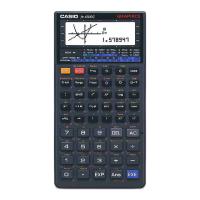
Do you have a question about the Casio FX-6300G and is the answer not in the manual?
| Brand | Casio |
|---|---|
| Model | FX-6300G |
| Category | Calculator |
| Language | English |
Procedure to reset the calculator for initial use.
Recommendation to back up important data due to memory fragility.
Identifying and fixing errors in programs using error messages.
Precautions and step-by-step guide for replacing batteries.
Explanation of keyboard markings and their meanings.
Understanding the calculator's display indicators and layout.
Diagram showing the location of all keys on the calculator.
Detailed explanation of key functions and operations.
Explains the meaning of various indicators on the calculator display.
Adjusts display contrast and indicates low battery.
Order of operations for formula calculations.
RUN, WRT, and PCL modes for calculator operation.
COMP, BASE-N, SD1, SD2, LR1, LR2 modes for calculations.
How to use array-type memories (Z[1], Z[2], etc.).
Performing basic addition, subtraction, multiplication, division.
Storing and recalling values using calculator memories.
Using parentheses to control calculation order.
Setting display formats (Fix, Sci) and canceling them.
Stores and recalls the result of the most recent calculation.
Allows using previous results in subsequent calculations.
Pinpoints the location of an error in a calculation or program.
Recalls and edits previously entered formulas.
Setting units for angles (Degrees, Radians, Grads).
Calculations involving logarithms and exponentials.
Converting between rectangular and polar coordinates.
Inputting, displaying, and converting fractional values.
Calculations involving sine, cosine, tangent, and their inverses.
Calculations involving sinh, cosh, tanh, and their inverses.
Converting numbers between different base systems.
Converting numbers between different base systems.
Performing regression analysis on data.
Calculating linear regression parameters from data.
Calculating exponential regression parameters from data.
Calculating standard deviation (population and sample).
Calculating logarithmic regression parameters from data.
Calculating power regression parameters from data.
Setting Xmin, Xmax, Xscl, Ymin, Ymax, Yscl for graph display.
Step-by-step process for setting graph range values.
How to store programs in memory using WRT mode.
How to execute stored programs using RUN mode.
How to interpret and handle error messages.
Explains Mem ERROR, Arg ERROR and their countermeasures.
Guidance for resolving specific error types like Syn, Ma, Go, Ne, Stk, Mem, Arg.
How to delete a program from a specific area.
How to delete all programs from memory.
Using Prog commands to call other programs as subroutines.
Avoiding memory overlap when using array-type memories.
Indicates formula or program syntax errors.
Indicates subroutine nesting overflow errors.
Indicates calculation range or input errors.
Indicates stack overflow errors in calculations.
Indicates errors related to Goto or Prog commands.
Indicates errors related to memory expansion or usage.
Indicates argument input errors for commands or functions.